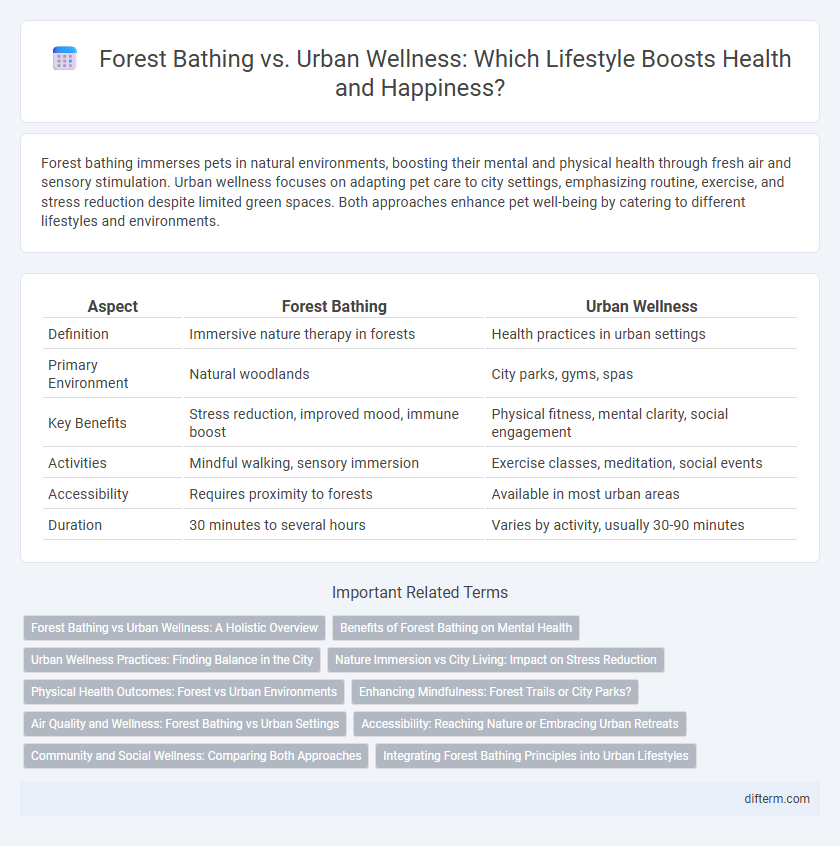Forest bathing immerses pets in natural environments, boosting their mental and physical health through fresh air and sensory stimulation. Urban wellness focuses on adapting pet care to city settings, emphasizing routine, exercise, and stress reduction despite limited green spaces. Both approaches enhance pet well-being by catering to different lifestyles and environments.
Table of Comparison
| Aspect | Forest Bathing | Urban Wellness |
|---|---|---|
| Definition | Immersive nature therapy in forests | Health practices in urban settings |
| Primary Environment | Natural woodlands | City parks, gyms, spas |
| Key Benefits | Stress reduction, improved mood, immune boost | Physical fitness, mental clarity, social engagement |
| Activities | Mindful walking, sensory immersion | Exercise classes, meditation, social events |
| Accessibility | Requires proximity to forests | Available in most urban areas |
| Duration | 30 minutes to several hours | Varies by activity, usually 30-90 minutes |
Forest Bathing vs Urban Wellness: A Holistic Overview
Forest bathing, rooted in the Japanese practice of shinrin-yoku, promotes mental clarity and reduces stress through immersive nature experiences, while urban wellness emphasizes accessible routines like yoga and mindfulness that suit city environments. Both approaches enhance overall well-being, but forest bathing uniquely benefits the immune system by increasing natural killer cell activity through exposure to phytoncides emitted by trees. Urban wellness focuses on creating balance amidst urban stressors with practices designed to improve cardiovascular health and mental resilience within limited green spaces.
Benefits of Forest Bathing on Mental Health
Forest bathing, also known as shinrin-yoku, significantly reduces stress hormones and lowers blood pressure by immersing individuals in natural forest environments, which enhances mental clarity and emotional stability. Studies show exposure to phytoncides released by trees boosts immune function and elevates mood more effectively than urban wellness practices centered around gyms or meditation studios. The multisensory engagement in forests promotes mindfulness and reduces anxiety and depression symptoms, offering a scientifically-backed mental health advantage over conventional urban wellness routines.
Urban Wellness Practices: Finding Balance in the City
Urban wellness practices emphasize creating balance amid city life by integrating mindfulness, regular exercise, and healthy nutrition into daily routines. Techniques such as guided meditation, yoga in parks, and curated wellness spaces promote mental clarity and reduce urban stress. These strategies foster resilience and improve overall well-being despite the fast pace and environmental challenges of metropolitan living.
Nature Immersion vs City Living: Impact on Stress Reduction
Forest bathing, or Shinrin-yoku, immerses individuals in natural environments, triggering physiological responses that lower cortisol levels and reduce heart rate, effectively mitigating stress. Urban wellness practices, while accessible, often incorporate green spaces and mindfulness techniques to counteract the sensory overload and fast pace of city living. Studies reveal that consistent nature immersion outperforms purely urban wellness routines in enhancing mental clarity, emotional stability, and long-term stress reduction.
Physical Health Outcomes: Forest vs Urban Environments
Forest bathing significantly enhances physical health outcomes by reducing blood pressure, lowering cortisol levels, and improving immune function through exposure to phytoncides and natural environments. Urban wellness practices, while beneficial, often rely on structured exercise and stress management techniques to mitigate the adverse effects of pollution and noise, which can limit cardiovascular and respiratory benefits. Studies show that immersive forest environments provide more substantial improvements in heart rate variability and inflammation markers compared to urban settings.
Enhancing Mindfulness: Forest Trails or City Parks?
Forest bathing in natural forest trails significantly enhances mindfulness by immersing individuals in a sensory-rich environment, promoting deep relaxation and mental clarity. City parks offer accessible green spaces that also support mindfulness through structured activities like yoga and meditation but may lack the immersive tranquility found in forests. Choosing forest trails over urban parks can lead to greater stress reduction and a heightened state of present-moment awareness.
Air Quality and Wellness: Forest Bathing vs Urban Settings
Forest bathing significantly improves air quality exposure by immersing individuals in natural environments rich in phytoncides and low in pollutants, promoting respiratory health and reducing stress hormones. Urban wellness spaces often face challenges such as elevated levels of particulate matter and nitrogen dioxide, which can diminish the benefits of outdoor activities. Prioritizing green spaces within cities enhances urban air quality and supports mental and physical well-being akin to forest environments.
Accessibility: Reaching Nature or Embracing Urban Retreats
Forest bathing offers immersive nature experiences that may require traveling to remote woodland areas, which can limit accessibility for urban residents. Urban wellness centers provide easily reachable retreats within city settings, featuring green spaces, meditation rooms, and wellness programs designed to bring nature-inspired benefits closer to daily life. Accessibility often depends on individual location and lifestyle preferences, influencing whether one opts for tranquil forest environments or convenient urban sanctuaries.
Community and Social Wellness: Comparing Both Approaches
Forest bathing fosters a sense of community by encouraging group immersion in natural settings, enhancing social bonds through shared outdoor experiences and mindfulness practices. Urban wellness initiatives build social wellness by creating accessible communal spaces like parks, wellness centers, and group fitness classes that promote interaction in diverse city environments. Both approaches support mental health and social cohesion, yet forest bathing emphasizes nature's role, while urban wellness leverages structured social programs and built environments.
Integrating Forest Bathing Principles into Urban Lifestyles
Integrating forest bathing principles into urban lifestyles enhances mental clarity and reduces stress by encouraging mindful immersion in natural elements such as parks, rooftop gardens, and green corridors. This practice promotes the benefits of phytoncides and calming sensory experiences typically found in forests, adapting them to city environments to improve overall well-being. Urban wellness programs increasingly incorporate nature-inspired activities that foster connection with greenery, improving air quality awareness and encouraging healthier lifestyle habits.
Forest Bathing vs Urban Wellness Infographic

 difterm.com
difterm.com